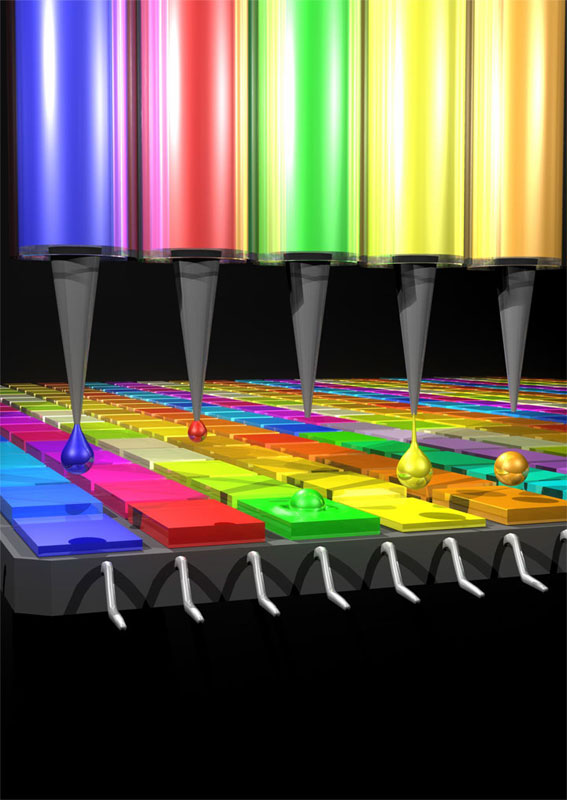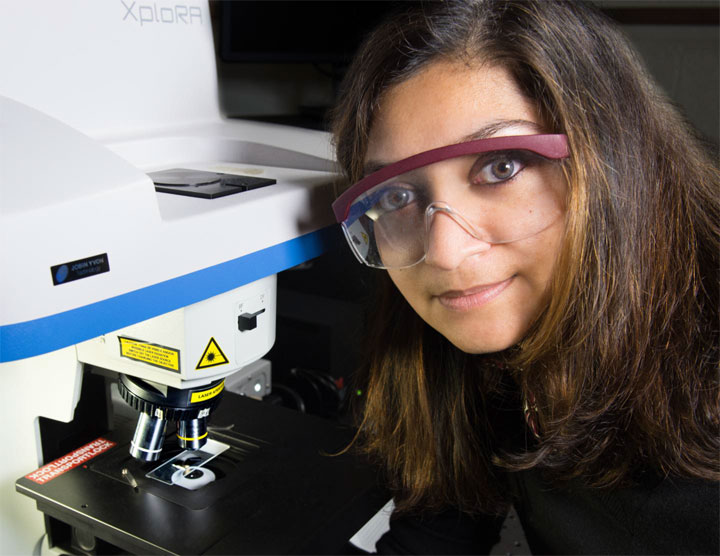A prototype of an imaging spectrometer based on quantum-dot technology could miniaturize and potentially revolutionize space-based spectrometers, particularly those used on uninhabited aerial vehicles and small satellites.
The research is a collaborative effort between NASA’s Goddard Space Flight Center and the Massachusetts Institute of Technology (MIT). NASA researchers are currently working to develop, qualify through thermal vacuum and vibration tests, and demonstrate a 20 × 20 quantum-dot array that is sensitive to visible wavelengths needed to image the sun and the aurora.

This illustration shows how a device prints the quantum dot filters that absorb different wavelengths of light depending on their size and composition. The emerging technology could give scientists a more flexible, cost-effective approach for developing spectrometers. Courtesy of O'Reilly Science Art.
Under the collaboration, researchers at NASA are developing an instrument concept specifically for a CubeSat application. Researchers at MIT are investigating techniques for synthesizing different precursor chemicals to create the dots, and then printing them onto a suitable substrate.
“Ultimately, we would want to print the dots directly onto the detector pixels,” said NASA research engineer and principal investigator Mahmooda Sultana.
The researchers believe that the technology could easily be expanded to cover a broader range of wavelengths, from UV to mid-IR. These wavelengths could be used for potential space applications in Earth science, heliophysics and planetary science.
“Higher-spectral resolution requires long optical paths for instruments that use gratings and prisms. This often results in large instruments,” said Sultana. “Whereas here, with quantum dots that act like filters that absorb different wavelengths depending on their size and shape, we can make an ultracompact instrument. In other words, you could eliminate optical parts, like gratings, prisms and interference filters.”
Just as important, the technology allows the instrument developer to generate nearly an unlimited number of different dots. As their size decreases, the wavelength of the light that the quantum dots will absorb decreases.

Principal Investigator Mahmooda Sultana has teamed with the Massachusetts Institute of Technology to develop a quantum dot spectrometer for use in space. In this photo, she is characterizing the optical properties of the quantum dot pixels. Courtesy of NASA/W. Hrybyk.
“This makes it possible to produce a continuously tunable, yet distinct, set of absorptive filters where each pixel is made of a quantum dot of a specific size, shape or composition,” Sultana said. “We would have precise control over what each dot absorbs. We could literally customize the instrument to observe many different bands with high-spectral resolution.”
“This is a very innovative technology,” she added, conceding that it is very early in its development. “But we're trying to raise its technology-readiness level very quickly. Several space-science opportunities that could benefit are in the pipeline.
“This is as novel as it gets,” said Sultana. “It really could simplify instrument integration.”
The original article about this technology appeared on the NASA web site.